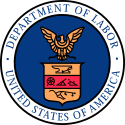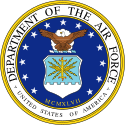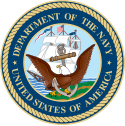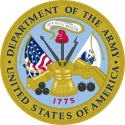USA:s regeringsdepartement
| USA |
 Denna artikel är en del i serien om: |
Övrigt
|
Atlas Politikportalen |
USA:s regeringsdepartement (engelska: United States federal executive departments) hör till de äldsta organisationerna av den federala statsmakten. De ursprungliga departementen – utrikes-, krigs- och finansdepartementen – inrättades med bara några veckors mellanrum under år 1789.
Nuvarande exekutiva departement
Idag (2012) existerar följande departement:
| Sigill | Namn | Chef | Grundat | 2009 års budget i miljarder dollar | Antal anställda (2007) |
|---|---|---|---|---|---|
 | USA:s utrikesdepartement (Department of State) | USA:s utrikesminister (Secretary of State) | 1789 | 16,39 | 18 900,0 |
 | USA:s finansdepartement (Department of the Treasury) | USA:s finansminister (Secretary of the Treasury) | 1789 | 19,56 | 115 897,0 |
 | USA:s inrikesdepartement (Department of the Interior) | USA:s inrikesminister (Secretary of the Interior) | 1849 | 90,00 | 71 436,0 |
 | USA:s justitiedepartement (Department of Justice) | USA:s justitieminister (Attorney General) | 1870 | 46,20 | 112 557,0 |
 | USA:s jordbruksdepartement (Department of Agriculture) | USA:s jordbruksminister (Secretary of Agriculture) | 1889 | 134,12 | 109 832,0 |
 | USA:s handelsdepartement (Department of Commerce) | USA:s handelsminister (Secretary of Commerce) | 1903 | 15,77 | 141 885,0 |
 | USA:s arbetsmarknadsdepartement (Department of Labor) | USA:s arbetsminister (Secretary of Labor) | 1913 | 137,97 | 17 347,0 |
 | USA:s försvarsdepartement (Department of Defense) | USA:s försvarsminister (Secretary of Defense) | 1947 | 651,16 | 3 000 000,0 |
 | USA:s hälso- och socialdepartement (Department of Health and Human Services) | USA:s hälsominister (Secretary of Health and Human Services) | 1953 | 879,20 | 67 000,0 |
 | USA:s bostadsdepartement (Department of Housing and Urban Development) | USA:s bostadsminister (Secretary of Housing and Urban Development) | 1965 | 40,53 | 10 600,0 |
 | USA:s transportdepartement (Department of Transportation) | USA:s transportminister (Secretary of Transportation) | 1966 | 73,20 | 58 622,0 |
 | USA:s energidepartement (Department of Energy) | USA:s energiminister (Secretary of Energy) | 1977 | 24,10 | 109 094,0 |
 | USA:s utbildningsdepartement (Department of Education) | USA:s utbildningsminister (Secretary of Education) | 1979 | 45,40 | 4 487,0 |
| USA:s veterandepartement (Department of Veteran Affairs) | USA:s veteranminister (Secretary of Veteran Affairs) | 1989 | 97,70 | 235 000,0 | |
 | USA:s inrikessäkerhetsdepartement (Department of Homeland Security) | USA:s inrikessäkerhetsminister (Secretary of Homeland Security) | 2003 | 40,00 | 208 000,0 |
| Summa budget & antal anställda: | $3 997,80 miljarder | 4 193 144 | |||
Tidigare exekutiva departement
| Sigill | Departement | Chef | Datum | Noteringar |
|---|---|---|---|---|
 | USA:s krigsdepartement (Department of War) | USA:s krigsminister (Secretary of War) | 1789–1947 | Omdöpt till armédepartementet 1947 |
 | USA:s postdepartement (Post Office Department) | USA:s generalpostmästare (Postmaster General) | 1792–1971 | Ombildades 1971 till den oberoende myndigheten United States Postal Service. |
| Inget | USA:s handel- och arbetsmarknadsdepartement (Department of Commerce and Labor) | 1903–1913 | Delat mellan handelsdepartementet och arbetsmarknadsdepartementet | |
 | USA:s armédepartement (Department of the Army) | USA:s arméminister (Secretary of the Army) | 1947–1949 | Från 1947-1949 hade cheferna för dessa kabinettsrang och rapporterade till försvarsministern (Secretary of Defense) som saknade ett eget departement. Från 1949 är dessa inte längre regeringsdepartement utan istället militärdepartement inom USA:s försvarsdepartement.[1] |
| USA:s marindepartement (Department of the Navy) | USA:s marinminister (Secretary of the Navy) | 1798–1949 | ||
 | USA:s flygvapendepartement (Department of the Air Force) | USA:s flygvapenminister (Secretary of the Air Force) | 1947–1949 | |
| Inget | USA:s hälso-, utbildnings- och välfärdsdepartement (Department of Health, Education, and Welfare) | 1953–1979 | Delat mellan hälso- och socialdepartementet och utbildningsdepartementet |
Se även
Referenser
- ^ Stewart, Richard W., red (2005). ”Chapter 24: Peace Becomes Cold War, 1945-1950” (på engelska). American Military History. Army Historical Series. "II". United States Army. sid. 531–533. http://www.history.army.mil/books/amh/amh-24.htm. Läst 23 mars 2011 Arkiverad 18 maj 2015 hämtat från the Wayback Machine.
| |||||||||||
Media som används på denna webbplats
The greater coat of arms of the United States of America, as depicted on passports, embassies and the Great Seal.
Seal of USA:s flygvapendepartement - militärdepartement inom USA:s försvarsdepartement
Seal of the United States Department of Homeland Security. A graphically styled American eagle appears in a circular blue field. The eagle's outstretched wings break through an inner red ring into an outer white ring that contains a circular placement of the words "U.S. DEPARTMENT OF" in the top half and "HOMELAND SECURITY" in the bottom half. The outer white ring has a silvery gray border. As in The Great Seal, the eagle’s left claw holds an olive branch with 13 leaves and 13 seeds while the right claw grasps 13 arrows. Centered on the eagle's breast is a shield divided into three sections containing elements that represent the homeland "from sea to shining sea." The top element, a dark blue sky, contains 22 stars representing the original 22 agencies and bureaus that have come together to form the department. The left shield element contains white mountains behind a green plain underneath a light blue sky. The right shield element contains four wave shapes representing the oceans, lakes and waterways alternating light and dark blue separated by white lines.
Seal of the United States Department of Housing and Urban Development.
The seal was originally unveiled on November 10, 1966, and later defined in law (Federal Register 32FR366-67 and 24 CFR subtitle A, §11.1, both since removed as part of a streamlining of the federal code). The seal was defined as:
On a white background within a circle composed of the words, "U.S. Department of Housing and Urban Development," is an eagle and two stars. The six upper bars depicting the upper portion of the eagle's wings, the torso of the eagle, the star at the right of the eagle, and the words, "U.S. Department of Housing and Urban Development," are colored blue. The eight lower bars depicting the lower portion of the eagle's wings and the star at the left of the eagle are colored green."
The seal is a representative of high rise buildings simulating an eagle and giving emphasis to the "urban" in HUD's name. The eagle (shown abstractly) is a symbol of Federal authority. The use of green symbolizes open space, land, growth and prosperity. The blue in the Seal alludes to the quality of life and environment in America's cities.
More information here.The seal of the United States Department of the Treasury.
The original seal dates from the Board of Treasury during the Articles of Confederation, and so predates the department (and Federal Government) itself. The current design is a slight simplification of the original, introduced in 1968.
The seal's arms depicts balancing scales (to represent justice), a key (the emblem of official authority) and a chevron with thirteen stars (to represent the original states).
For more information, see here.Seal of the United States Department of Justice.
The origins of the seal are unknown; it was first used in the 19th century as the seal for the Office of the Attorney General (prior to the formation of the Department of Justice) but the exact date is unknown. Even the translation of the Latin motto is murky, a matter of debate between Latin scholars. The Department's currently accepted translation is who prosecutes on behalf of Lady Justice, referring to the Attorney General. The motto is an allusion to the wording of the writ in a qui tam action: qui tam pro domino rege quam pro se ipso sequitur ("he who sues on behalf of our lord the King as well as for himself." The current-day seal dates from 1934, when some (though not all) of the heraldic mistakes on the original were corrected. More information here.The seal of the United States Department of Health and Human Services. The symbol represents the American People sheltered in the wing of the American Eagle, suggesting the Department’s concern and responsibility for the welfare of the people. The colors are reflex blue and gold.
This seal is now just used for mainly legal purposes; the department has a separate logo which is used for its visual identity.
More information here and here.Seal of the United States Department of Education.
The seal was introduced on May 7, 1980, and is described in law as:More information here and 34 CFR Part 3.Standing upon a mound, an oak tree with black trunk and limbs and green foliage in front of a gold rising sun, issuing gold rays on a light blue disc, enclosed by a dark blue border with gold edges bearing the inscription "DEPARTMENT OF EDUCATION" above a star at either side of the words "UNITED STATES OF AMERICA" in smaller letters in the base; letters and stars in white.
Seal of the United States Department of Transportation, introduced on 17 November 1980. The seal is described in 49 CFR 3.1 as 'A white abstract triskelion figure signifying motion appears within a circular blue field. The figure is symmetrical. The three branches of the figure curve outward in a counter-clockwise direction, each tapering almost to a point at the edge of the field. Surrounding the blue circle is a circular ring of letters. The upper half of the ring shows the words “Department of Transportation”. The lower half of the ring shows the words “United States of America”. The letters may be shown in either black or medium gray. The official seal of the Department is modified when embossed. It appears below in black and white.'
The former seal of the now-defunct United States Department of War. It is now used as the seal of the United States Department of the Army. Can be found in: Benson John Lossing, ed. Harper's Encyclopedia of United States History (vol. 2) (New York, NY: Harper and Brothers, 1912). More information can be found here.
*Description: On a circular background of fair sky and moderate sea with land in sinister base, a tri-mast square rigged ship under way before a fair breeze with after top-sail furled, commission pennant atop the foremast, National Ensign atop the main, and the commodore's flag atop the mizzen. In front of the ship a luce-type anchor inclined slightly bendwise with the crown resting on the land and, in front of the shank and in back of the dexter fluke, an American bald eagle rising to sinister regarding to dexter, one foot on the ground, the other resting on the anchor near the shank; all in proper colors. The whole within a blue annulet bearing the inscription "Department of the Navy" at the top and "United States of America" at the bottom, separated on each side by a mullet and within a rim in the form of a rope; inscription, rope, mullet, and edges of annulet all gold. *Background: The policy for use of the Navy seal and emblem is contained in SECNAV Instr 5030.4 and SECNAV Instr 5030.6. The seal design was approved by the President of the United States by Executive Order 10736 dated October 23, 1957. Request for use of the Navy emblem should be submitted in writing to Defense Printing Service, ATTN: DPSMO, 8725 John Kingman Rd Suite 3239, Fort Belvoir, VA 22060-6220. The telephone number is (703) 767-4218. 1879 version here: http://etc.usf.edu/clipart/54900/54985/54985_seal_navy.htm
Seal of the United States Department of the Interior.
The seal consists of a male bison with the head and body in a left position, standing on a prairie, with mountains and a rising sun in the background, enclosed within two concentric circles, having the words "U.S. Department of the Interior" and the date "March 3, 1849" (when Congress created the department) inscribed in the top and bottom arcs within these circles. See here for more information.
The bison seal dates from 1917, when it was used as the emblem on the initial department flag and thereafter replaced the old version of the seal, which used a federal eagle. The eagle was reinstated for a few years in the 1920s, and a different seal was used from 1968-69, but on both occasions the bison seal was reinstated. For more information see this chapter in The Department of Everything Else: Highlights of Interior History.The creation of the new Department of Veterans Affairs in 1989 required a new official seal to represent VA. In November 1988, after the law establishing VA as a cabinet department was signed, VA initiated a competition among employees for a seal design that would give the new department a "new look." The winner of that competition, and creator of today's VA seal was David E. Gregory, a medical media production specialist at the Indianapolis VA Medical Center. These are the key elements of the seal, as he described them:
- The eagle represents the United States.
- The circle of five stars above the eagle represents the Army, Navy, Air Force, Marines and Coast Guard.
- The two flags in the eagle's talons represent the span of America's history from 13 colonies to the present 50 states.
- The flags are bound by a golden cord symbolic of those Americans who have fallen in service to their country.
- The eagle holds the cord to perpetuate the memory of those veterans who have fallen and sacrificed for the nation.
Seal of the United States Department of State. It is mostly composed of the Great Seal of the United States.
Seal of the United States Department of Commerce.
The seal was approved on April 4, 1913 and is derived from the seal of the defunct United States Department of Commerce and Labor. It is composed of the arms (Per fesse azure and or, a ship in full sail on waves of the sea, in chief proper; and in base a lighthouse illumined proper), and crest ("The American Eagle displayed"). Around the arms, between two concentric circles, are the words "Department of Commerce" and "United States of America".
The official symbolism has been modified as the functions of the department have changed. As of 2007: the ship is a symbol of commerce; the blue denotes uprightness and constancy; the lighthouse is a well-known symbol representing guidance from the darkness which is translated to commercial enlightenment; and the gold denotes purity. The crest is the American bald eagle denoting the national scope of the Department's activities.
Full description at CFR Title 15 Part 1Seal of the United States Department of Agriculture.
The USDA seal was created in 1895. It was adapted for use as a general identifier in 1980, but those usages were replaced with the USDA Logo in 1996. The seal has been withdrawn from use as a departmental identifier, though it is still used on legal materials and other internal uses.
The seal is defined as:Two and three-eights inches in diameter (azure), a shock of corn (or), upon a base (vert) an American plough proper. All within a double annulet (argent), outer roped, inner beaded, charged with the inscription: UNITED STATES DEPARTMENT OF AGRICULTURE, and at the base, a scroll bearing the legend: "1862.AGRICULTURE IS THE FOUNDATION OF MANUFACTURE AND COMMERCE. 1889." (or). A diapered background of 44 stars (argent) for the States of the Union.
The dates on the scroll represent the year the Department was founded by act of Congress (1862), and the year the Department was made an Executive Office headed by a Secretary of cabinet rank (1889). The 44 stars represent the states in the Union in 1889.
See here and here for more information.Seal of the former United States Department of the Post Office.
Seal of the United States Department of Defense from 2001 to 2022.




















